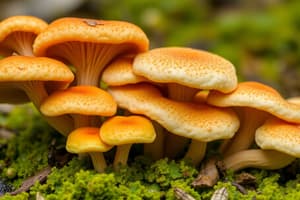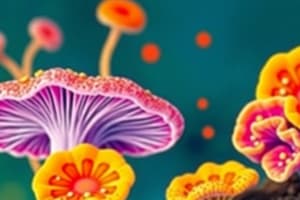Podcast
Questions and Answers
What is the main difference between fungi and plants?
What is the main difference between fungi and plants?
- Fungi obtain energy from other organic substances and plants make their own energy (correct)
- Fungi have cell walls made of cellulose and plants have cell walls made of chitin
- Fungi reproduce through seeds and plants reproduce through spores
- Fungi are autotrophs and plants are heterotrophs
What do fungi and plants both use for structural support?
What do fungi and plants both use for structural support?
- Glucose
- Chitin
- Cellulose (correct)
- Chlorophyll
How do fungi and plants differ in their method of obtaining nutrients?
How do fungi and plants differ in their method of obtaining nutrients?
- Fungi produce their own nutrients through photosynthesis and plants obtain nutrients from the environment
- Fungi break down organic material by secreting digestive enzymes and absorbing the nutrients, while plants absorb nutrients directly from the air (correct)
- Fungi absorb nutrients from the soil and plants absorb nutrients through their leaves
- Fungi obtain energy from sunlight and plants obtain energy from other organic substances
Which type of plants do not have specialized structures for transportation?
Which type of plants do not have specialized structures for transportation?
What distinguishes vascular plants from nonvascular plants?
What distinguishes vascular plants from nonvascular plants?
Which type of plants reproduce through seeds contained within a fruit?
Which type of plants reproduce through seeds contained within a fruit?
What is the ancestral relationship between fungi and plants?
What is the ancestral relationship between fungi and plants?
What is the primary role of fungi in the ecosystem?
What is the primary role of fungi in the ecosystem?
Which phylum of fungi includes mushrooms and evolved around 815 to 715 million years ago?
Which phylum of fungi includes mushrooms and evolved around 815 to 715 million years ago?
What is responsible for the absorption and transportation of nutrients in fungi?
What is responsible for the absorption and transportation of nutrients in fungi?
Study Notes
- Fungi and plants are immobile organisms, with fungi having hyphae resembling plant roots
- Fungi do not contain chloroplasts and have a chitin cell wall
- Approximately 3.8 million species of fungi exist, with only 100,000 identified
- Fungi play an essential ecological role as decomposers, breaking down organic matter and releasing nutrients into the soil
- Earliest fungi were likely aquatic and symbiotic with photosynthetic bacteria
- Fungi first appeared in the fossil record around one billion years ago
- Five main phyla of fungi exist: Chytridiomycota, Zygomycota, Ascomycota, Basidiomycota, and Deuteromycota
- Basidiomycota, which includes mushrooms, evolved around 815 to 715 million years ago
- Early plant life, including photosynthetic eukaryotic protists, evolved around 1700 million years ago and were confined to an aquatic environment until around 510 to 439 million years ago
- Bryophytes were early nonvascular land plants, including mosses and liverworts
- Fungi have adapted to various harsh conditions, including being discovered in Antarctica, living in cockroaches, and nuclear power plants
- Fungi filled an important role during the Devonian Era and the K-T extinction event
- Fungi are crucial for the breakdown of detritus and the release of nutrients into the soil
- Mycelium, a network of hyphae, is responsible for the absorption and transportation of nutrients in fungi
- Mushrooms, part of the Basidiomycota, reproduce by releasing spores
- The development of fruiting bodies was a significant evolutionary leap for sexual reproduction in the fungi kingdom.
Studying That Suits You
Use AI to generate personalized quizzes and flashcards to suit your learning preferences.
Description
Discover the distinctions between fungi and plants, debunking the misconception of their similarities. Explore the unique features and characteristics of these organisms, including their modes of reproduction and methods of obtaining nutrients.




